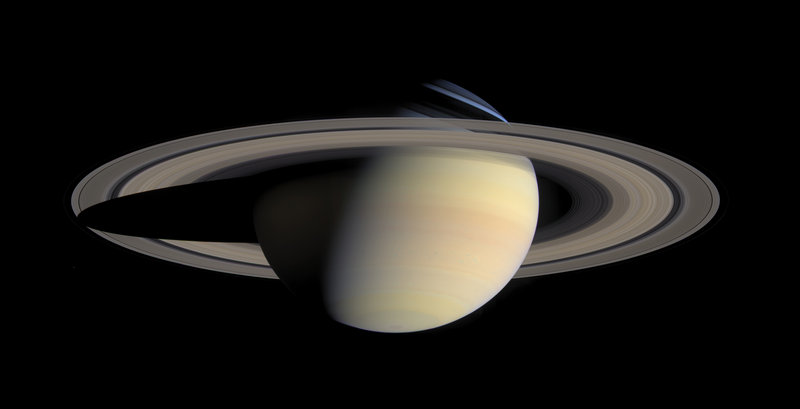WASHINGTON – One of the solar system’s most evocative mysteries — the origin of Saturn’s rings — may be a case of cosmic murder, new research suggests.
The victim: an unnamed moon of Saturn that disappeared about 4.5 billion years ago. The suspect: a disk of hydrogen gas that once surrounded Saturn when its dozens of moons were forming, but has now fled the crime scene. The cause of death: a forced plunge into Saturn.
And those spectacular and colorful rings are the only evidence left. As the doomed moon made its death spiral, Saturn robbed its outer layer of ice, which then formed rings, according to a new theory published online Sunday in the journal Nature.
“Saturn was an accomplice and that produced the rings,” said study author Robin Canup, an astronomer at the Southwest Research Institute in Boulder, Colo.
The mystery of Saturn’s rings “has puzzled people for centuries,” said Cornell astronomer Joe Burns, who wasn’t involved in the study and said Canup’s new theory makes sense.
One of the leading theories has been that either some of Saturn’s many moons crashed into each other, or an asteroid crashed into some of them — leaving debris that formed the rings. The trouble is Saturn’s moons are half ice and half rock and the planet’s seven rings are now as much as 95 percent ice and probably used to be all ice, Canup said. If the rings were formed by a moon-on-moon crash or an asteroid-on-moon, there would be more rocks in the rings.
Something had to have stripped away the outer ice of a moon, a big moon, Canup said.
So her theory starts billions of years ago when the planets’ moons were forming. A large disk of hydrogen gas circled Saturn and that helped both create and destroy moons.
According to Canup’s computer model, Saturn stripped the ice away from a huge moon while it was far enough from the planet that the ice would be trapped in a ring. The gas disk pulled the moon into the planet.
The rings and ice-rich inner moons are the last remnants of this lost moon, “which is pretty neat,” Canup said.
Burns said Canup’s theory explains the heavy ice components of rings better than other possibilities. Larry Esposito, who discovered one of Saturn’s rings, praised the new paper as “a very clever, original idea.”
“I would call it more like cosmic recycling,” Esposito said.
Send questions/comments to the editors.



Success. Please wait for the page to reload. If the page does not reload within 5 seconds, please refresh the page.
Enter your email and password to access comments.
Hi, to comment on stories you must . This profile is in addition to your subscription and website login.
Already have a commenting profile? .
Invalid username/password.
Please check your email to confirm and complete your registration.
Only subscribers are eligible to post comments. Please subscribe or login first for digital access. Here’s why.
Use the form below to reset your password. When you've submitted your account email, we will send an email with a reset code.